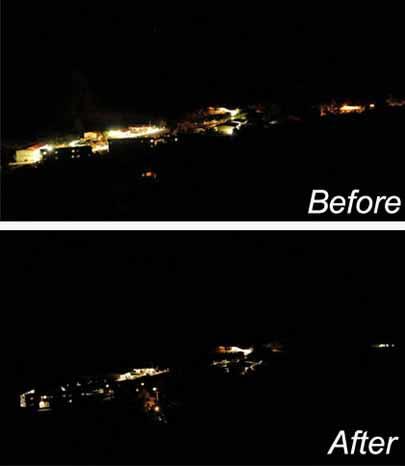Big Bend National Park has long been known as a great place to enjoy the night sky, and thanks to a recently completed project, nighttime has gotten even darker, especially around the park's main developed area in the Chisos Basin.
The park is involved in an impressive multi-phase project to retrofit all its exterior lighting fixtures. The goals of the effort are to reduce light pollution, reduce energy consumption and provide better and safer illumination for visitors and staff. The first phase, which re-lamped the exterior lighting at the Panther Junction Visitor Center and gas station, was completed in June of 2009.
The completion of the Chisos Basin work marks the completion of the second of four phases in the project, and included the entire lodging area, restaurant, and amphitheater area. The path lighting between the amphitheaters and campgrounds at Rio Grande Village and Cottonwood has also been completed. The remaining phases will be the completion of work at Rio Grande Village, campground comfort stations, and the historic cabin area in the Chisos Basin.
During the work at Chisos Basin, existing exterior lighting, including building and path lighting, was retrofitted with new LED (light emitting diode) fixtures. According to the park, "the new LED fixtures utilize technology that provides comparable light with dramatically less electricity, have an average life of 50,000 hours and provide a natural moon glow color-rendering effect. These new fixtures are designed to complement existing infrastructure, blend into the landscape, and are appropriately shielded, providing illumination where needed on the horizontal plane."
The new LED fixtures are rated at less than 1 watt each and replace 60 watt incandescent and fluorescent lamps. That adds up to some impressive results: a 98% reduction in wattage, energy consumption, and greenhouse emissions. Park budgets are always tight, and this project will provide some welcome cost savings. It's estimated that annual energy bills for the equipment that was replaced will drop from $3,292 to $164.
I spent several days—and nights—in the Chisos Basin in March, and have to agree the results of the new lighting are impressive. Guests in the lodge area have adequate light to navigate safely on foot after dark, but if you're in the Basin and venture even a few feet off the lighted pathways—to retrieve something from your parked vehicle, for example—you'll probably want a flashlight. It's a pleasant change from the urban and suburban setting most of us are accustomed to at home.
Big Bend has some of the best night skies in the country, and ironically, the most significant source of light pollution in Big Bend was from light sources within the park itself. Park officials note that prior to this project, visitors in the Chisos Basin could not see the spectacular night skies due to the spillover of the exterior lighting in the area. The old exterior lighting was so strong, it cast shadows on the mountains around the basin. Now, the night skies are clearly visible.
"This is a great project that we wanted to celebrate tonight,” said the park’s superintendent, William Wellman, during the recent dedication ceremony. “The amount of energy that will now be used to light the Chisos Basin is a tiny fraction of the energy used with the old style lights. So from an environmental standpoint, and a sustainability standpoint, it’s a really good project."
“You just do not get that many projects that have this wide a range of benefits. So I think this one is really worth celebrating. We are proud to be working in concert with surrounding towns and agencies to improve the quality of the night skies in the Big Bend region."
Elsewhere in West Texas, the city of Alpine, Texas, adopted a lighting ordinance in 2000 to reduce light pollution and is working on revisions to the lighting ordinance to further reduce the impacts of artificial lighting. McDonald Observatory and the town of Ft. Davis, located north of Big Bend, have long been proactive in reducing light spillover in the Big Bend region.
The Big Bend lighting project is a collaborative effort with the National Park Service and a Best Lighting Practices grant with Musco Lighting. This grant is administered through the National Park Foundation and the NPS' Denver Service Center, and part of the funding is coming from the Friends of Big Bend National Park. Forever Resorts, Inc., contributed labor and made other donations to the project, which is among the first of its kind of this scope in the National Park System.
A link to a short video about the project is available on the park website.




Add comment